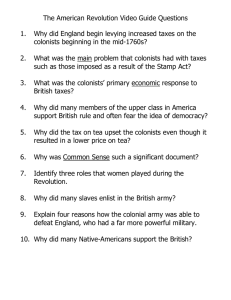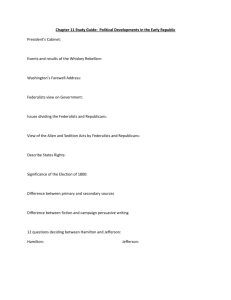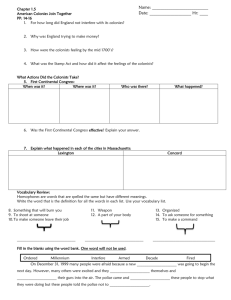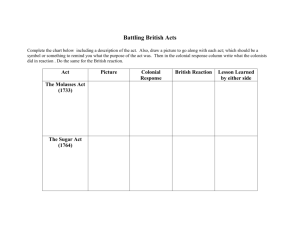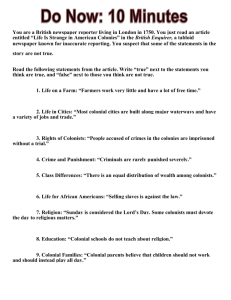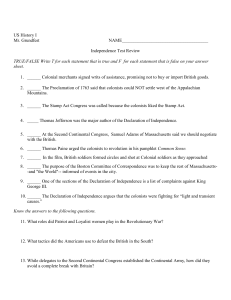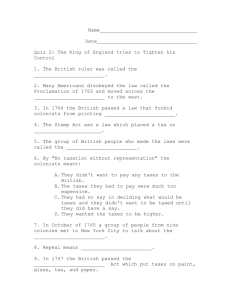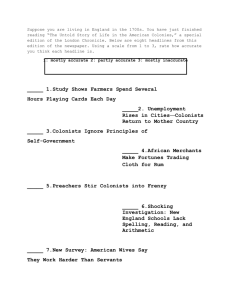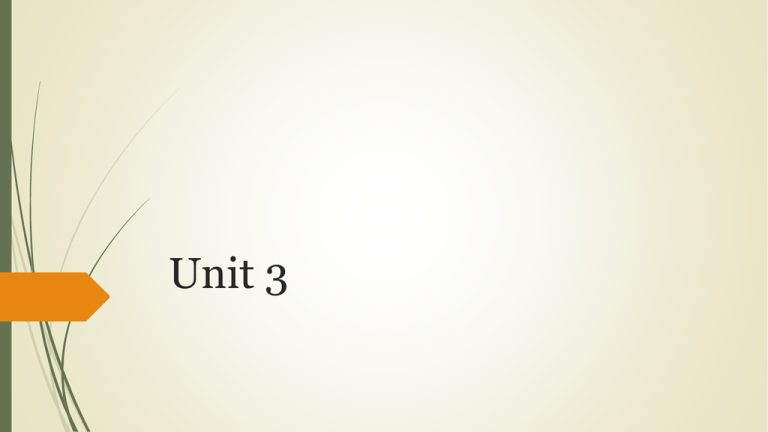
Unit 3
Chapter 5
The American Revolution
106-116 QUIZ
1. King _________________ took the throne in 1760, frustrating both parliament and the
colonists throughout his reign.
2. The Proclamation Line of __________ frustrated the colonists following the French
and Indian War.
3. The ___________________ act discouraged bribery, smuggling and other illegal acts
by LOWERING the tax on molasses.
4. The ________ _____ placed a tax on documents and printed matter such as
newspapers, marriage licenses wills, and deeds.
5. On March 5, 1770 this event ended with 5 colonial deaths, sparking a
propaganda campaign throughout the colonies.
Structure of Colonial Society
1760s an optimistic post-war period
Striking ethnic and racial diversity
60% of population under twenty-one years old
Relatively high per-capita GDP
Wealth unevenly distributed
South has richest individuals, and 90% of non-free colonial
population
Middle colonies
New England lags behind because of lack of export products
Breakdown of Political Trust
1760—George III ascends throne
Despite limited ability, wants to take
more active role in government
Upsets Whigs by ignoring their role
High turnover among top ministers
Hard for Parliament to get adequate information
on colonies
Parliamentary sovereignty
English officials assume that Parliament
must have ultimate authority
Question to keep in mind:
How did the various English
colonists come to see themselves as
“Americans”?
No Taxation without Representation!
Colonists try to reserve internal colonial authority for their own
legislatures
Colonists assume their legislatures equal in some ways to Parliament
Americans not represented at all in Parliament
British officials espouse “virtual representation”
What is this?
“It should think, feel, reason
and act like them”
- John Adams
Colonists insist only colonial assemblies should represent Americans
Ideas About Power and Virtue
John Locke and “Commonwealthmen" shape
colonial political thought
Rebellion against arbitrary government
justified
Bad government reflects sin and corruption
Colonists see British officials as sinful and
corrupt
Newspapers ensure wide dissemination of
political confrontations
Proclamation of 1763
What’s the economic situation following the war?
Colonists doubt the army’s value
Pontiac’s War
Exposes the British army’s weakness
Reveals the desperate situation of Native
Americans after withdrawal of French
Frontier racism: Paxton Boys
Who are the Paxton Boys?
Colonists determined to settle trans-Appalachian West
Proclamation of 1763 bans settlement in trans-Appalachian
West
Colonists see post-war army as there to enforce
proclamation
The Sugar Act
Prime Minister George Grenville
attempts to reduce England’s war debt
Revenue Act of 1764 (the Sugar Act)
INDIRECT TAX!
What did it say?
Merchants and gentry protest; most
colonists ignore
Stamp Act - 1765
What did it say?
DIRECT TAX!!
Patrick Henry and the Virginia Resolves
unite the gentry and the mass of the
population in protest
Stamp Act Congress petitions the king and
Parliament for repeal
Sons of Liberty protest includes riots, mob
violence, and boycotts
Colonists were afraid this was
setting a precedent, what was this
precedent?
Stamp Act
protest
Stamp Act protest
A Boston crowd burns bundles of
the special watermarked paper
intended for use as stamps.
(Library of Congress)
• How did Britain respond to these protests?
• What was the Declaratory Act?
Townshend Acts
• Charles Townshend: chancellor of the exchequer
• Townshend Acts of 1767- INDIRECT duty tax
Followed the Mutiny (Quartering) Act
Tax on imported lead, paper, paint, tea
• Dissolved the NY Assembly after Mutiny Act
• Response?
Boycott of British goods
Colonial solidarity forming
Tensions rise so 4,000 troops stationed in Boston
NOTEWORTHY:
The Townshend Act only collected £259
for the Crown, while it cost the Crown
£170,000 to enforce it.
Britain suspended all the taxes, except
for the tax on tea.
-Is the war inevitable Y/N? Why?
Impending Storm
March 5, 1770 – “Boston
Massacre”
5 dead colonists
Who’s fault was it?
A massacre?
Committees of
Correspondence unifying
force
Boston Massacre
Shortly after this incident, one Bostonian observed
that "unless there is some great alteration in the state
of things, the era of the independence of the colonies
is much nearer than I once thought it, or now wish
it." (Library of Congress)
Ideas of Revolution
Gradual shift towards “American” ideas
Separation of powers WRITTEN by
colonial gov’t
Checks on power
Representation and taxation
arguments
Want for “actual” representation
Taverns and Churches places of
radicalism, esp. in NE.
Boston Tea Party
1773—Parliament passes Tea Act
Designed to help the East India
Company by making the sale of
its tea cheaper in America
Dec. 16, 1773 – Boston Tea Party
Why were the colonists so angry?
Boston Tea Party
Boston Tea Party
In this 1775 drawing of the Boston Tea Party, bare-chested Americans, their hair pulled back
Indian-fashion, pour tea into the harbor. The British lion appears as the figurehead of the tea
ship, in case the true object of the protest was in doubt. The artist also added a large crowd of
colonists content to watch rather than do anything to prevent this destruction of private
Copyright © Houghton Mifflin Company. All rights reserved.
property. (Library of Congress)
Coercive (Intolerable) Acts
Port of Boston closed until tea paid for
Massachusetts government re-structured
Upper house made appointive body
Town meetings permitted only once a year
Accused officials to be tried in England, not America
Army authorized to quarter troops wherever needed
Revolution begins
• Committees of Correspondence
• 1774 – First Continental Congress
rejected a plan for colonial union under British authority
Statement of grievances
Recommended military preparations
Agreed to a series of boycotts
Agreed to meet the next Spring
Lexington and Concord
•
April 18, 1775
•
General Thomas Gage has orders to arrest Sam Adams and John
Hancock in Lexington
•
Tries to seize gunpowder in Concord
Send 1000 men to seize the ammunition
•
William Dawes and Paul Revere
“The redcoats are coming!”
•
18 casualties in Lexington
•
“Shots heard ‘round the world”
Advantage? Disadvantage?
GREAT BRITAIN
COLONIALS
•Pop. of 7.5 million
•Pop. Of 2.5 million
•Prof. Army of 50,000
•Small, untrained militia
•Hessian mercenaries
•No centralized govt.
•Royal treasury
•No treasury
•Royal navy
•No navy
•Divided parliament
•Long lines of supply
•Poor generalship
•More cannon, arms, &powder
•Many Colonials remain loyal
•Emancipated slaves join GB
•Angry France, Irish problem for GB
•Defending homes
•Washington, Franklin
•Few armories, little powder
Second Continental Congress
Began by John Adams
Appoints General
Washington head of Continental Congress
Prints currency
Sends Benjamin Franklin to France Why??
……………Battle of Bunker Hill
http://www.cr
.nps.gov/nr/t
whp/period.ht
m
Olive Branch Petition
July 8, 1775
Not angry at King George III
Who were they angry
at?
DENIED!!
“Blockade the rebels!”
George Washington
owned his own copy!!
•Written by Thomas Paine
•47 page essay attacking the King
and Parliament
“I find
Common
Sense is
working a
powerful
change in
the minds
of many
men.”
- G.W.
Copyright © Houghton Mifflin Company. All rights reserved.
“Common Sense”
“The nearer any government approaches to a republic the less
business there is for a king. It is somewhat difficult to find a
proper name for the government of England. Sir William
Meredith calls it a republic; but in its present state it is
unworthy of the name, because the corrupt influence of the
crown, by having all the places in its disposal, hath so
effectively swallowed up the power, and eaten out the virtue
of the house of commons that the government of England is
nearly as monarchical as that of Franceor Spain.”
Declaration of Independence
Continental Congress
appoints a committee to
prepare a declaration
Thomas Jefferson chosen to
express declaration
Draws on philosophy of the
Enlightenment
States began to draft their own
constitutions and Congress drafted
the Articles of Confederation, the
first Constitution of the colonies.
Ideas of John Locke, “natural
rights”
Right to resist tyranny
Declaration of Independence
It should be noted…
1.
Power is derived from the consent of the governed =
people
2.
King’s power is not a “divine right.” Rather, the people
have unalienable rights.
3.
Original draft was rejected by South Carolina and
Georgia because it attacked the slave trade.
4.
The call for Equality was not originally meant to
include women or minorities.
5.
Second Continental Congress called for independence on
July 2, 1776, and adopted the Declaration on July 4th.
LOYALISTS
Maybe 1/3 of colonists were
loyalists
Loyalists were stronger in the
South
members of King’s govt. in
colonies,
judges, governors, etc. AND
many ordinary colonists.
PATRIOTS
Perhaps 1/3 to 1/2 of the colonists
were patriots = calling for
independence.
Tended to come from those who
wanted more economic
independence.
*Many Americans tried to stay
neutral, esp. Quakers.
African-Americans fought on both
sides.
Native Americans tended to side
with the British.
Mobilizing for War
Congress had trouble
raising money for the
war effort.
Why?
Created a Continental
Army
George Washington
made General
Steadiness, courage,
dedication to the cause
Battle of Bunker Hill
•June 17, 1775
•2,400 Redcoats
•Britain lost over 1,000 men!
•MORAL VICTORY!....why?
“Don’t shoot until
you see the white
in their eyes!” –
General Prescott
Battle of New York
August 1776
British Army moves to the middle states
Why?
32,000 soldiers + mercenaries sail into the New York
Harbor
Gen. Howe wanted humiliation and surrender
Read an offer of amnesty
Continental Army had 23,000 men
LOST and had to retreat August 27th, 1776
The contribution and sacrifice of the Maryland
Line at the Battle of Long Island during the
American Revolution
On August 27, 1776, some four hundred Maryland troops led a
rear-guard action to check the British advance and protect
the retreat of Washington's greatly outnumbered army. The
Marylanders launched six counter attacks at the Cortelyou
House. During the last attack, Cornwallis' troops were
reinforced and the Marylanders were swept back to the
Gowanus Canal. After the battle, 256 Marylanders were
buried in a mass grave that is located a few blocks from the
park.
It is for this heroic action that Maryland became known as the
Old Line State.
“Good God, what brave fellows I must this day lose.”
–George Washington.
http://www.sos.state.md.us/MMMC/vt3-md400.html
ONLY 9 men, including the leader of the MD forces, Mordecai
Gist, survived.
….By late fall Washington has been
pushed across the Delaware River into
Pennsylvania.
He had ONLY 8,000 troops left!
HE STARTED WITH 23,000!
Trenton and
Princeton
The tide is turning for
the Patriots!
•The Continental army needed a win
ASAP!!
•Why??
•Trenton: Christmas 1776
Washington makes a strike
•Travels across the Delaware in
rowboats!
•Captures over 1,000 Hessians!
•6 days later he wins at Princeton
•How??
•Another sneak attack
Looking back on it,
what mistake did
Howe make after
Washington fled
NY??
http://www.britishbattles.com/images/trenton/trenton-map-l.jpg
Battle of Trenton, Christmas 1776
“Parade with me my brave fellows!”
Philadelphia Falls
General Howe wanted to take Philadelphia
He forced out Washington’s troops and Congress was
also forced to flee
More continental losses:
Brandywine
Germantown
The British enjoy the winter in Philly!
Winter at Valley Forge
Winter 1777-1778
Terrible winter with few supplies.
LOW POINT FOR THE
COLONIAL ARMY.
Troops that remain are committed
and trained by Baron von Steuben.
Inadequate:
Food
Supplies
Firewood
shelter
Washington’s description of Valley Forge
“It may be said that no history can furnish an instance of an
Army’s suffering uncommon hardships as ours has done.
To see men without clothes to cover their nakedness,
without blankets to lay on, without shoes, by which their
marches might be traced by the blood from their feet, and
almost as often without provision as with. Marching
through frost and snow, and at Christmas taking up their
winter quarters within a day’s march of the enemy, without
a hut to cover them until they could be built and submitting
to it without a murmur, is a mark of patience and obedience
which in my opinion can scarcely be paralleled.”
General George Washington
BATTLE OF SARATOGA
Benedict Arnold vs. Burgoyne
KEY IDEA: Control the water, Control the land
BRITISH OBJECTIVE: Divide the colonies
How??
REBEL STRATEGY: Delay the British link-up,
using winter as an ally.
TURNING POINT: British defeat at Saratoga
RESULT: Delay the British and brings France in on
side of the Americans!!
NOTE: Benedict Arnold
later betrays the cause,
jealous and petulant
Britain had 440 killed, 700 wounded,
over 6,000 captured!
Franco- American Alliance
France gives:
Gunpowder
Munitions
***(90% of American
gunpowder in first 2+ years
comes from France!!)
Americans get:
A wider war:
France, Spain, Holland
fighting in North America,
South America, Asia,
Caribbean, and on the high
seas.
France gets:
Ally in the New World
A weakened Britain,
Protection for her sugar
colonies in the West Indies
Possibly New France back as
well
Most of its supplies,
training, and naval support
European Allies Shift the Balance
Baron Friedrich von Steuben
Marquis de Lafayette
•Believed in the colonists’ cause
Made “regular soldiers
out of country
bumpkins” at Valley
Forge
•Became a very close friend of G.W.
•Suffered through Valley Forge
•Called for France to help out
British Move South
Didn’t fare too well in the
Middle and Northern colonies
Hoped they could seize ports
and launch attacks on the
French in the West Indies.
What are other reasons?
Early Success in the South
Spring 1779 – British controlled Georgia
Clinton replaces Howe in N.Y.
Charles Cornwalis led the expedition in the
South
May 1780 – Battle of Charles Town
British captured 5,500 colonial soldiers
August 1780 - British win another big victory at
the Battle of Camden
Nathanael Greene replaces Horatio Gates
•African Americans begin to
enter the war
•Who are they usually
fighting for and why?
Colonists Fight Back
Swamp Fox – Francis Marion
Jan. 1781 – Battle of Cowpens
Cornwalis scored a victory at the
Guildford Court House, but lost ¼ of
his men in the process
What were some of the issues the British
were having?
Where did Cornwalis decide to go
next? Why was it such a mistake?
Battle of Yorktown, Oct. 17, 1781
http://www.britishbattles.com/images/yorktown/map-l.jpg
Winning the Peace
Treaty of Paris of 1783:
Recognized the independence of the United States
Recognized Florida, Mississippi and Old North West (Ohio, etc.) as part of
U.S.
**No provisions on when the British will leave their forts in the West
** colonists promised to pay back debts to England and give land back to
Loyolists
Negotiated by Ben Franklin, John Adams, and John Jay
Americans make a separate peace with England, frustrating French and
Spanish imperial ambitions
Chapter 6
The Republican Experiment
Defining Republican Culture
Republicanism—new core ideology
Uncompromising commitment to liberty and equality
Varying answers resulted in variety of republican governments
Revolution introduced unintended changes into American society
Hierarchical social relations challenged
Fundamental questions raised about the meaning of equality
Social and Political Reform
Cincinnatus Crisis
Changes in laws of inheritance to erase feudal
elements
Property qualifications for voting reduced
Capitols moved to enable better representation for
frontier settlers
Separation of church and state
African Americans in the New Republic
Abolitionist sentiment spread in wake of the Revolution
African Americans embraced Declaration’s stress on natural rights
Northern states
By 1800, slavery was legally dying in North
Racism and segregation remained
Southerners debated abolition
Some individuals freed slaves
Economic motives overcame republican ideals
Cotton gin breathed new life into slavery
All wanted to abolish the slave trade except SC and GA
Why?
How slavery survived:
Racist assumptions about inferiority of blacks
Enormous economic investments
No alternative
What would happen to black people?
The Challenge of Women’s Rights
Pre-Revolutionary trend ended tyranny in the family
Women demanded the natural right of equality
Women more assertive in divorce, economic life
Denied political and legal rights
Had to take over the homes
Some traveled with the men – “camp followers”
“In the new code of laws which I suppose it will be necessary for you to make, I
desire you would remember the ladies and be more generous and favorable to
them than your ancestors.”
Abigail Adams
Very little changes for women following the war
Natural Rights and the State Constitutions
What type of government did the people want?
Rhetoric of Equality
Reality of Inequality
State constitution writers insisted on preparing written documents
State constitutions guaranteed natural rights:
Freedom of religion
Freedom of speech
Freedom of the press
Private property
Trial by jury
Governors weakened
Elected legislatures given most power
HOW TO RULE?
Republic, YES.
Supreme power? NO!!!
SOLUTION…..a confederation
How is a confederation different from a federal government ( what we
have today)?
Articles of Confederation
The Limits of Limited Government:
1.
No common currency or banking laws
2.
Unable to settle disputes over commerce between states
3.
Unable to have stable govt. funding or to collect taxes
4.
Unanimity necessary to amend (Rhode Island creates
problems!!!)
5.
Unable to deal with foreign powers, i.e. N. African Pirates
6.
Weak army and navy
7.
Unable to respond to Shay’s rebellion
Representation by population
or State?
Equal…..but not really
How?
Supreme Power: Can it be
divided?
The Articles of Confederation
created a confederation within the
United States
Fed. Govt. could:
How should
representatives be
decided?
Declare war
Make peace
Sign treaties
Borrow money
Coin Money
Members saw themselves
as citizens of their states
Therefore: 1 vote/state
Deal with Natives
BUT, they have
no executive,
therefore no way
to enforce it!
Western Lands: Who gets them?
Land Ordinance of 1785
Northwest Ordinance of
1787
Decided:
Government in the
West
How to elect a
temporary govt.
How to apply for
statehood
1779 – 12 states had
approved Articles
MD did not – b/c of land
claims
Why was MD so afraid
of Western land claims?
Solution: land is
property of United
States
Passed in 1781
Map: The United States in 1787
The United States in 1787
This map shows the extent of
American westward settlement in
1787 and the limits placed on that
settlement by French and Spanish
claims west of the Mississippi and in
Florida. Plans for the creation of three
to five states in the Northwest
territory were approved by Congress
in 1787, ensuring that the settlers in
this region would enjoy the same
political rights as the citizens of the
original thirteen states.
Map: Western Land Claims and Cessions, 1782-1802
Western Land Claims and Cessions, 17821802
After the United States achieved
independence, states competed with each other
for control of valuable lands to which they had
possible claims under their original charters.
That competition led to a series of
compromises among the states or between
individual states and the new nation, which are
indicated on this map.
Northwest Territory
The Nationalist Critique
Restoration of trade with Britain caused trade deficit and hard
currency shortage
Congress unable to address trade, inflation, and debt
Congress had no power to tax
The Genius of James Madison
Recognition by 1780s of shortcomings in small state republics
Ordinary citizens not virtuous enough for a republic
Majority did not preserve the property rights of the minority
Stronger central government gained support
James Madison persuaded Americans that large republics could be free and
democratic
Competing factions would neutralize each other
Federalist #10
Shays’s rebellion
•Shays’s Rebellion
•1787 – 1,200 farmers rebelled over their
large debts and lack of paper money
•Why was this such a big issue for
the U.S.A.?
• EVERY state was in debt, it was just a
matter of time until another rebellion arose
somewhere else.
•New govt. was needed!
Letter of Amnesty
The Philadelphia Convention
Convened May 1787
Fifty-five delegates from all states except
Rhode Island
Secrecy rule imposed
Why?
State Govt. v. Nat. Govt. Power
VIRGINIA PLAN
James Madison ,Edmund
Randolph:
NEW JERSEY PLAN
William Paterson
“Bicameral” (2 House)
Legislature, based on pop.
“Unicameral” (1 House) legislature
Voters elect “Lower”
House
Each state receives 1 vote (1 state = 1
vote)
Lower House elects
“Upper” House
Who supports this idea?
Who likes this idea? Why?
Continental Congress can’t
reach a decision
acceptable to everyone
BUILDING A NEW GOVERNMENT
SOLUTION:
Roger Sherman and Franklin: The Great Compromise
Bicameral Legislature
Upper House: “Senate”
Senators elected by state legislatures
Each state given equal representation
Lower House: “House of Representatives”
Reps. elected by voters in each state
# of Reps. based on state’s population
3/5ths compromise for South.
Was this a good solution? Opinion?
Representative Democracy and Checks and Balances
THREE – FIFTHS COMPROMISE
To Ratify or Not to Ratify?
Jeffersonians
Anti-Federalists:
Madisonians
Federalists:
AGAINST RATIFICATION
FOR RATIFICATION
WHY: Suspect the elite, suspicious of
tyranny
WHY: Stability and Strength needed to
secure economy and the high seas
WHO: Poor farmers, frontiersmen,
states’ rights advocates
WHO: Propertied classes, merchants,
bankers
Map: Federalist and Antifederalist Strongholds, 1787-1790
Federalist and Antifederalist Strongholds, 1787-1790
Federalists drew their primary backing from densely populated areas along major transportation routes, where trade,
mobility, and frequent contact with people in other states encouraged a nationalistic identity. Antifederalist support came
from interior regions where geographic isolation bred a localistic perspective. However, some westerners, especially in
Copyright
Houghton
Mifflin Company. All rights reserved.
Georgia and western Virginia, voted for a strong central government that would push back the
Indians© or
the Spanish.
Adoption and Adaptation
Needed 9 states
technically, but…
Federalists wanted?
Anti-Federalists
wanted?
The Federalist Papers
(New York Public Library)
Adding the Bill of Rights
Rights included:
Freedom of assembly, speech, religion,
the press, and bearing arms
Speedy trial by a jury of peers
No unreasonable searches
First ten amendments added by December 1791
Adoption and Adaptation
Completing the Structure
Establishing the Executive Departments
GW and Adams craft:
State
Treasury
War
Att. Gen.
Establishing a New Government
George Washington unanimously elected
president, 1788
Judiciary Act of 1789 established Supreme Court
and thirteen District Courts
1789—5% tariff levied to fund government
CONFLICTING VISIONS
ALEXANDER HAMILTON
Washington’s aide-de-camp in
Revolution
Secretary of the Treasury
Wanted stronger ties to Britain
Believed strong central government
preserves national independence
Envisioned U.S. as an industrial
power
Feared anarchy more than
tyranny
THOMAS JEFFERSON
Secretary of state under Washington
Believed limited government
preserves liberty
Envisioned U.S. as an agrarian
nation
Trusted the common people
Against large debt
Hamilton’s Plan
Congress asked Hamilton for suggestions for solutions to debt problem
He produced three reports:
Public Credit
Banking
Manufacturers
Debt of $54 million, additional state debt of $25 million
80% of debt held by speculators
Federalists and Republicans
Competing National Visions
“Centralizers” vs. “Republicans”
•
Hamilton and the Federalists
• Hamilton’s “Funded” Debt Proposal –
National BANK
•
Enacting the Federalist Program
• Objecting to the Funding Bill
• Compromise on the National Capital
• Division over Hamilton’s Program
• Why??
Setback For Hamilton
Report on Manufacturing (1791) sought federal
encouragement for manufacturing
Protective tariffs and industrial bounties
Madison warned that program would
strengthen federal government at state
expense
Jefferson warned that the rise of cities would
destroy agriculture and agrarian civic virtue
Southerners opposed to protective tariffs
Hamilton’s recommendations defeated
Federalists and Republicans
• The Republican Opposition
• Establishment of the Federalist Party
• Formation of the Republican Party
• Regional and Economic
Differences
French Revolution…
Which side do each favor? Why?
What did Washington decide to do?
90
Establishing National Sovereignty
• Maintaining Neutrality with France
and England
• Jay’s Treaty
• How does this create more
partisan division?
• Pinckney’s Treaty
• What did these two treaties say?
Popular Political Culture
Political “parties” condemned as factions
Widespread concern over loss of common
revolutionary purpose
Common people highly literate
Newspapers widely read, highly
influential
Newspapers shrill, totally partisan
Federalists and Republicans suspected each
others’ loyalty
Party members thought it a patriotic duty
to destroy opposing party
Political clubs promoted political
ideas
Clubs associated with Republican
party
Newspapers and clubs the main
sources of political information
Establishing National Sovereignty
• Whiskey Rebellion
• What happened?
• How did it increase
partisan factionalism?
93
GW Farewell Address
“It serves always to distract the public councils and enfeeble the
public administration. It agitates the community with illfounded jealousies and false alarms; kindles the animosity of
one part against another; foments occasionally riot and
insurrection. It opens the door to foreign influence and
corruption…”
-What was GW referring to?
What was the partisan purpose behind this speech?
Does it still seem relevant to today?
The Downfall of the Federalists
The Election of 1796
John Adams Elected,
factionalism a problem
95
The Adams Presidency
Bitterly divisive election in 1796
Federalists divided, Hamilton tried to push
Pinckney over Adams
Adams forced to accept people not supportive in
cabinet
Republican Jefferson is vice-president
Federalist Department heads more loyal to
Hamilton than Adams
Problems With France
The “XYZ Affair”
What happened?
The “Quasi War”
Protecting American Shipping
97
(Naval Historical Center)
Crushing Political Dissent
Federalists began building up the army
Ostensible purpose: repel French invasion
Actual intention: stifle internal opposition
Hamilton commanded army, controlled officers
Hamilton sought declaration of war against France to begin operations
against dissent
Adams created navy, refused to ask Congress for war
99
Alien and Sedition Acts
Alien and Sedition Acts
Purpose to silence Republicans
First civil liberties crisis
Gave president power to expel any foreigner
Required U.S. residency of fourteen years for citizenship
Criminalized criticism of the government
Why are these piece of legislation so obviously partisan?
Kentucky and Virginia Resolutions
Republicans saw Alien and Sedition Acts as dire threat to liberty
Virginia and Kentucky Resolutions said states have final say in determining
constitutionality of federal law
Jefferson’s Kentucky Resolutions—states may nullify unconstitutional federal law
Madison’s Virginia Resolutions—urged states to protect their citizens
Purpose of resolutions: clarify differences between Republicans and Federalists, not
justify secession
What precedent does this set? Why are there such important long-term consequences?
The Peaceful Revolution: The Election of 1800
Federalists lost, but Republicans Jefferson and Burr tied
Lame duck Federalist House of Representatives would break the tie
Hamilton and Federalists decided Jefferson better than Burr
Twelfth Amendment separated votes for president and vice-president to avoid
repeat of this situation
© 2011, The McGraw-Hill Companies, Inc. All Rights Reserved.
102
Midnight Judges
Adams and the “midnight judges”
Chief Justice John Marshall
What happened? Why is this important?
Jefferson’s inaugural: “we are all republicans, we
are all federalists”
Federalists lost touch with public

